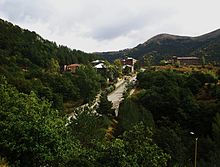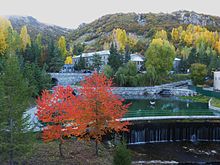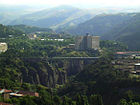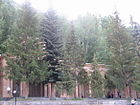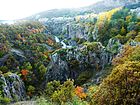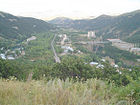- Jermuk
-
For the drink, see Jermuk (water).
Jermuk
ՋերմուկJermuk 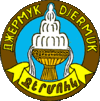
SealCoordinates: 39°50′30″N 45°40′20″E / 39.84167°N 45.67222°ECoordinates: 39°50′30″N 45°40′20″E / 39.84167°N 45.67222°E Country  Armenia
ArmeniaMarz Vayots Dzor Government – Mayor Vardan Hovhannisyan Area – Total 55.14 km2 (21.3 sq mi) Elevation 2,080 m (6,824 ft) Population (2009) – Total 6,200 – Density 112.7/km2 (291.9/sq mi) Time zone GMT +4 (UTC+4) – Summer (DST) GMT+5 (UTC+5) Sources: Population [1] Jermuk (Armenian: Ջերմուկ; also Romanized as Djermuk, formerly, Safolar) is a spa town in the southern Armenian province of Vayots Dzor, 53 km east of Yeghegnadzor, the capital of Vayots Dzor. It was a popular destination during the Soviet era and nowadays is still famous for its hot springs and its brand of mineral water that is bottled in the vicinity. The town is considered to be attractive for its huge waterfall, the natural bridge, the lake, its forests with the walking trails and mineral water pools. Jermuk is currently being redeveloped to become a modern centre of tourism and health services. The town is also being set up to become a sort of Chess centre, with numerous chess tournaments hosted or scheduled to be hosted. Finally, Jermuk is well-known among the Armenian people for its distinctively fresh air.
Contents
History
Jermuk occupies an area which is historically considered as part of the Vayots Dzor district of the Syunik province (within Armenia Mayor). It was first mentioned in the 13th century by historian Stepanos Orbelian in his work about the "History of the Sisakan district". But the ruins of an ancient fortress and an 8th century basilica testify that the human settlement near the fountains of Jermuk has started long before the 13th century. The fortress of Jermuk was built during the rule of the Artaxiad Dynasty.[2]
In ancient times the mineral water of Jermuk was known for its curing features. The princes of Syunik regarded the Jermuk sources and water as healing and built several pools filled with it, thereby making the little town their holiday destination.
During the 1830s, a Russian engineer-geologist called "Voskoboynikov" arrived in Armenia and began explorations on Jermuk's geographical depth as well as the contents and characteristics of Jermuk waters. His observations on Jermuk were published in the "Mountain Magazine" journal in 1831, and later in 1855, in the "Caucasian Calenda" magazine. Voskoboynikov’s works were the first scientific talks on Jermuk.
In 1860s, all the historic pools of Jermuk which were built by the Orbelian princes of Syunik, were renovated by "Gevorg Khanagyan", following a resolution by the Russian government. Today, those baths which are called "Pristav Pools", are preserved as historical monuments.
The foundation of the modern town of Jermuk took place only in 1940, when the first sanatorium was opened to the public, thus setting for the fertile activity of the Jermuk health resort centre. Development programmes were implemented to turn Jermuk into a modern resort for all Soviet nationals. In 1980 the population of Jermuk reached 10,000. After the collapse of the Soviet Union and as a result of the economic crisis in Armenia during the 1990s, the population dropped to 7000 in the beginning of the 21st century. Recently however, the Armenian authorities took steps in order to further develop the Jermuk town-resort including the settlement of Kechut. As a result of those new resolutions the town has experiencеd unprecedented success as a tourist destination.
Geography
The town is located at a height of 2080 meters above sea level, within the mountains of Vayots Dzor, among thick forests, on a plateau divided into two parts by the gorge of Arpa River, 170 km south-east of Yerevan. Surrounding mountains of Vayots Dzor, Vardenis and Syunik are all covered with forests and alpine meadows at a height of 2500–3000 meters.
The forests of Jermuk are rich with oak and hornbeam trees, as well as with dog rose, wild pear, plum and juniper plants. Animals like foxes, rabbits, badgers and bears could be found there.
Jermuk is full of natural hot springs (Geysers). The name itself is derived from this fact, as the word "jermuk" means "geyser" in the Armenian language. The waterfall of Jermuk on Arpa river has a height of 70 meters.
The average temperature of Jermuk is +15.3C during summer and -9C in winter with a level of 800 mm (31.50 in) of annual precipitation.
Economy and tourism
The natural water bottling industry has its deep roots in the town as the first factory was founded in 1951. Nowadays, Jermuk is home to many giant factories which produce bottled mineral water. The sparkling water of Jermuk is largely exported to markets around the world.
The main water producers of Jermuk are the following companies:
- Jermuk Mineral Water Factory (Jermuk Mayr Gortsaran) founded in 1951
- Jermuk Group founded in 1999
- Jermuk Etalon
Another key sector in the economy of Jermuk is tourism. The town is home to several high-quality health resorts and spas, and it is one of the main touristic destinations for those who visit Armenia. Visitors could enjoy the beautiful nature of Jermuk and the mountains of Vayots Dzor (3000 meters), the waterfalls, the curing water pools, hotels and health spas, sanatoriums, the ropeway and alpine sports facilities. Annually, during the month of August to be precise, the town hosts the FIDE Grand Prix Jermuk chess tournament. One of the most attractive nearby destinations is the Gndevank Monastery, located just 10 km west of Jermuk. This monastery is more than 1000 years old.
Sister cities
 Saint-Raphaël, France
Saint-Raphaël, France
Gallery
- Jermuk
References
- Jermuk at GEOnet Names Server
- Report of the results of the 2001 Armenian Census, National Statistical Service of the Republic of Armenia
- World Gazeteer: Armenia – World-Gazetteer.com
- Kiesling, Brady (2005), Rediscovering Armenia: Guide, Yerevan, Armenia: Matit Graphic Design Studio
External links
- Jermuk article on Armeniapedia
- Jermuk guide on Haykland
- Jermuk FIDE Grand Prix 2009
- Jarmuk Ashkhar resort
- Jermuk Armenia resort
- Jermuk Yeghnik resort
- Jermuk
Capital: YeghegnadzorVayk 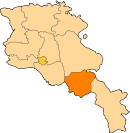
Jermuk Gndevaz · JermukYeghegnadzor Categories:- Populated places in Vayots Dzor
- Mountain resorts in Armenia
- Ski areas and resorts in Armenia
Wikimedia Foundation. 2010.



